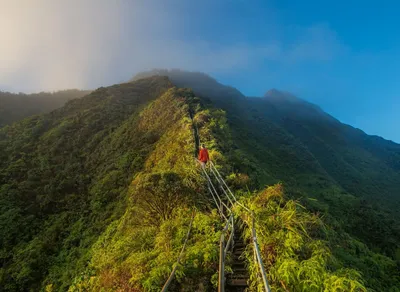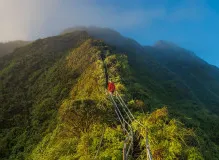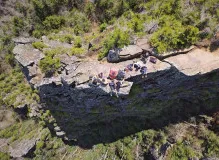For over long years, we have diligently conducted independent research and product testing. When you make a purchase through our links, we may earn a commission.
The Ultimate Guide to Hiking Mount Fuji 🗻
Created: 6 minutes ago

6 min Read
If you're an adventure seeker and love the great outdoors, then hiking Mount Fuji should be on your bucket list. Located in Japan, Mount Fuji is an iconic and majestic mountain that attracts thousands of hikers every year. Standing at 3,776 meters (12,389 feet) tall, it is the highest peak in Japan and offers breathtaking views of the surrounding landscapes.
In this comprehensive guide, we will take you through everything you need to know about hiking Mount Fuji. From the best hiking trails to essential climbing gear, weather conditions to hiking seasons, safety tips to hiking durations, we've got you covered. So, put on your hiking boots, pack your bags, and let's embark on an unforgettable adventure up Mount Fuji!
Table of Contents
- Introduction to Mount Fuji
- Mount Fuji Hiking Trails
- Preparing for the Mount Fuji Hike
- Hiking Mount Fuji: Tips and Safety
- The Mount Fuji Hiking Experience
- Conclusion
Introduction to Mount Fuji
🏔️ Mount Fuji, also known as Fuji-san, is an active stratovolcano located about 100 kilometers southwest of Tokyo, Japan. It is one of the most recognizable natural landmarks in the country and holds significant cultural and spiritual importance. Mount Fuji has been an object of worship for centuries and has inspired countless artists, poets, and climbers.
Rising above the surrounding landscape, Mount Fuji is often capped with a snow-capped peak, creating a stunning sight that can be seen from miles away. Its symmetrical cone shape has become an icon of Japan and is a symbol of natural beauty and resilience. Hiking Mount Fuji provides you with an opportunity to experience the awe-inspiring power of nature and witness breathtaking views from its summit.
Mount Fuji Hiking Trails
When it comes to hiking Mount Fuji, there are several trails to choose from, each offering a unique experience. Here are some of the most popular hiking trails to the summit:
Yoshida Trail
⛰️ The Yoshida Trail is the most commonly used trail to ascend Mount Fuji. It starts from the fifth station, located at an elevation of 2,300 meters (7,546 feet), and takes hikers through the scenic landscape of the Fuji Subaru Line 5th Station. The trail is well-maintained and offers various amenities such as restrooms, shops, and even a post office.
Hiking the Yoshida Trail typically takes about 5 to 7 hours to reach the summit and 3 to 5 hours to descend. The trail is relatively moderate in difficulty, making it suitable for hikers of various skill levels. However, it is important to note that the trail can get crowded during the peak hiking season, so starting early is recommended.
Subashiri Trail
⛰️ The Subashiri Trail is another popular route to hike Mount Fuji. Starting from the Subashiri 5th Station at an elevation of 2,000 meters (6,562 feet), this trail offers a slightly more challenging and less crowded alternative to the Yoshida Trail. The trail takes hikers through beautiful forests and rocky terrain, providing a diverse hiking experience.
Hiking the Subashiri Trail typically takes about 6 to 8 hours to reach the summit and 3 to 5 hours to descend. The trail offers stunning views of the surrounding landscapes and allows hikers to witness the unique vegetation that thrives on the slopes of Mount Fuji.
Gotemba Trail
⛰️ The Gotemba Trail starts from the Gotemba 5th Station, which is situated at an elevation of 1,400 meters (4,593 feet). This trail is known for its challenging and steep terrain, making it suitable for experienced hikers seeking a more adventurous climb. The trail offers panoramic views of the surrounding mountains and valleys.
Hiking the Gotemba Trail typically takes about 8 to 10 hours to reach the summit and 4 to 6 hours to descend. Due to its higher starting point, hikers need to be well-prepared and in good physical condition to tackle this trail. It is also important to note that the Gotemba Trail is less crowded compared to the Yoshida and Subashiri trails, providing a more secluded hiking experience.
Fujinomiya Trail
⛰️ The Fujinomiya Trail is the shortest and steepest route to the summit of Mount Fuji. Starting from the Fujinomiya 5th Station at an elevation of 2,400 meters (7,874 feet), this trail offers a challenging and thrilling hiking experience. The trail takes hikers through rocky terrain, steep slopes, and sections with chains for assistance.
Hiking the Fujinomiya Trail typically takes about 4 to 6 hours to reach the summit and 2 to 3 hours to descend. Due to its steepness and challenging terrain, this trail is recommended for experienced hikers with good physical fitness and mountaineering skills. The trail provides breathtaking views of the surrounding landscapes and allows hikers to truly appreciate the rugged beauty of Mount Fuji.
Preparing for the Mount Fuji Hike
Before embarking on a Mount Fuji hike, it is essential to make necessary preparations to ensure a safe and enjoyable experience. Here are some important factors to consider:
Mount Fuji Altitude
🏔️ Mount Fuji's altitude is a significant factor to consider when planning your hike. As the altitude increases, the air becomes thinner, and the oxygen levels decrease, leading to altitude-related illnesses and difficulties in breathing. It is important to acclimatize to the altitude and allow your body to adjust gradually.
When hiking Mount Fuji, it is recommended to spend at least one night at a mountain hut located at the 7th or 8th station to acclimatize. This helps to reduce the risk of altitude sickness and ensures a safer ascent.
Best Time to Hike Mount Fuji
⏰ The best time to hike Mount Fuji is during the official climbing season, which typically runs from early July to early September. During this period, the weather conditions are relatively stable, and the mountain huts and facilities are fully operational.
Hiking outside the official climbing season is highly discouraged due to the harsh weather conditions and limited support available. Mount Fuji's weather can be unpredictable, and extreme winds, sub-zero temperatures, and heavy snowfall can occur even during the summer months.
Mount Fuji Climbing Gear
⚙️ Proper climbing gear is essential for a successful and safe hike up Mount Fuji. Here are some of the key items you should include in your hiking gear:
-
Hiking boots: Invest in a sturdy pair of hiking boots with good ankle support and non-slip soles. This will provide stability and protect your feet during the steep and rocky sections of the trail.
-
Appropriate clothing: Dress in layers to accommodate the changing weather conditions on the mountain. Include a waterproof and windproof outer layer, as well as thermal base layers to keep you warm. Don't forget to bring gloves, a hat, and sunglasses to protect yourself from the sun and cold temperatures.
-
Backpack: Choose a backpack that is comfortable to carry and has enough capacity to carry your essentials. Remember to pack lightweight and compact items to minimize the weight on your back.
-
Headlamp: A headlamp or flashlight is essential, especially if you plan to hike during the night or witness the sunrise from the summit. It will provide you with adequate visibility in the dark and help you navigate the trails.
-
Food and water: Pack enough snacks and water to keep yourself hydrated and energized throughout the hike. There are shops and mountain huts along the trail where you can refill your water bottles and buy additional supplies if needed.
-
First aid kit: Carry a basic first aid kit with essentials such as band-aids, painkillers, blister pads, and any personal medications you may require.
Remember to pack light and only bring the essentials to avoid unnecessary weight and strain during the hike.
Frequently Asked Questions (FAQs)
What is the best time to hike Mount Fuji?
The best time to hike Mount Fuji is during the official climbing season, which typically runs from early July to early September.
How difficult is hiking Mount Fuji?
Hiking Mount Fuji can be quite challenging, especially due to the high altitude and steep terrain. It is recommended for experienced hikers with proper fitness levels.
Are there any age restrictions for hiking Mount Fuji?
There are no official age restrictions for hiking Mount Fuji. However, it is important to consider the physical ability and endurance of individuals, especially children and older adults.
Do I need any special equipment for hiking Mount Fuji?
While hiking Mount Fuji, it is essential to have appropriate hiking gear, including sturdy hiking boots, warm clothing, a headlamp, trekking poles, and sufficient food and water.
Are there any accommodation options on Mount Fuji?
Yes, there are several mountain huts and lodges available for overnight stays on Mount Fuji. It is recommended to make reservations in advance, especially during the peak climbing season.
What are the different hiking routes on Mount Fuji?
There are four main routes to the summit of Mount Fuji: Yoshida Trail, Subashiri Trail, Gotemba Trail, and Fujinomiya Trail. Each route varies in terms of difficulty and duration.
Are there any safety precautions to consider while hiking Mount Fuji?
Yes, it is important to monitor weather conditions, carry a map and compass, stay hydrated, and avoid hiking alone. Familiarize yourself with the emergency procedures and guidelines provided by local authorities.
Can I hike Mount Fuji without a guide?
Yes, it is possible to hike Mount Fuji without a guide. However, it is recommended to have prior hiking experience, good physical fitness, and adequate knowledge of the route.
Are there any restrictions on hiking Mount Fuji due to volcanic activity?
In case of volcanic activity or other safety concerns, access to Mount Fuji may be restricted. It is advisable to check with the local authorities or visitor centers for any current restrictions before planning your hike.
What should I do if I experience altitude sickness while hiking Mount Fuji?
If you experience symptoms of altitude sickness, such as headache, nausea, or dizziness, it is important to descend to a lower elevation immediately and seek medical attention if necessary.


